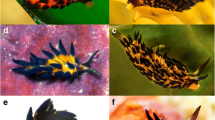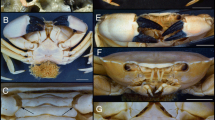Abstract
Morphological examination and molecular analyses of specimens of the genus Limacia collected in the Eastern Pacific Ocean indicate that four species of Limacia occur in the region. Limacia cockerelli, previously considered to range from Alaska to Baja California, is common only in the northern part of its former range. An undescribed pseudocryptic species, previously included as L. cockerelli, occurs from Northern California to the Baja California Peninsula and is the most common species of Limacia in Southern California and Northern Mexico. Another new species similar to L. cockerelli is described from Antofagasta, Chile and constitutes the first record of the genus Limacia in the Southeastern Pacific Ocean. These two new species are formally described herein. Finally, Limacia janssi is a genetically and morphologically distinct tropical species ranging from Baja California to Panama. Species delimitation analyses based on molecular data and unique morphological traits from the dorsum, radula, and reproductive systems are useful in distinguishing these species









Similar content being viewed by others
References
Akaike H (1974) A new look at the statistical model identification. IEEE Trans Autom Control 19:716–722
Angulo-Campillo OJ (2003) Variación espacio-temporal de las poblaciones de opistobranquios (Mollusca: Opisthobranchia) en tres localidades de B.C.S., Mexico. Master of Science Thesis, Departamento de Pesquerías y Biología Marina, Centro Interdisciplinario de Ciencias Marinas: La Paz, Baja California Sur, Mexico (unpublished).
Angulo-Campillo O (2005) A four year survey of the opisthobranch fauna (Gastropoda, Opisthobranchia) from Baja California Sur, Mexico. Vita Malacologica 3:43–50
Baba K (1937) Opisthobranchia of Japan (II). Jour. Dept. Agr. Kyushu Imp. Univ. 5:289–344, pls.1–2.
Behrens (2004) Pacific Coast Nudibranchs, Supplement II New Species to the Pacific Coast and New Information on the Oldies. Proc Calif Acad Sci 55(2):11–54
Behrens DW, Hermosillo A (2005) Eastern Pacific nudibranchs, a guide to the opisthobranchs from Alaska to Central America. Sea Challengers, Monterey, California. 137 pp., 314 photos.
Bertsch H (2014) Biodiversity in La Reserva de la Biósfera Bahía de los Ángeles y Canales de Ballenas y Salsipuedes: Naming of a new genus, range extensions and new records, and species list of Heterobranchia (Mollusca: Gastropoda), with comments on biodiversity conservation within marine reserves. The Festivus 46:158–177
Bertsch H, Ferreira AJ (1974) Four new species of nudibranchs from tropical West America. The Veliger 16:343–353
Briggs JC, Bowen BW (2012) A realignment of marine biogeographic provinces with particular reference to fish distributions. J Biogeogr 39:12–30
Caballer M, Almón B, Pérez J (2016) The sea slug genus Limacia Müller, 1781 (Mollusca: Gastropoda: Heterobranchia) in Europe. Cah Biol Mar 57:35–42
Clark T (2006) ‘Limacia cockerelli.’ Available at http://week.divebums.com/2006/Jun12-2006/index.html [7th image from top]. Accessed 15 July 2016.
Coleman N (2008) Nudibranchs Encyclopedia. Catalogue of Asia/Indo-Pacific sea slugs. Neville Coleman’s Underwater Geographic Pty: Springwood Queensland, Australia, 416 pp
Cooke S, Hanson D, Hirano Y, Ornelas-Gatdula E, Gosliner TM, Chernyshev AV, Valdés A (2014) Cryptic diversity of Melanochlamys sea slugs (Gastropoda, Aglajidae) in the North Pacific. Zool Scripta 43:351–369
Di Lorenzo E, Mantua NJ (2016) Multi-year persistence of the 2014/15 North Pacific marine heatwave. Nat Clim Chang. doi:10.1038/nclimate3082
Filatov D (2002) Proseq: a software for preparation and evolutionary analysis of DNA sequence data sets. Mol Ecol Not 2:621–624
Folmer O, Black M, Hoeh W, Lutz R, Vrijenhoek R (1994) DNA primers for amplification of mitochondrial cytochrome c oxidase subunit I from diverse metazoan invertebrates. Mol Mar Biol Biotechnol 3:294–299
Goddard JHR (1984) The opisthobranchs of Cape Arago, Oregon, with notes on their biology and a summary of benthic opisthobranchs known from Oregon. The Veliger 27:143–163
Goddard JHR (1998) A summary of the prey of nudibranch molluscs from Cape Arago, Oregon. Opisthobranch Newsletter 24:11–14
Goddard JHR (2004) Developmental mode in benthic opisthobranch molluscs from the northeast Pacific Ocean: feeding in a sea of plenty. Can J Zool 82:1954–1968
Gonsalves-Jackson DC (2004) Opisthobranch mollusks across the Isthmus of Panama: systematics and biogeographic distribution of developmental types. Dissertation, Florida Institute of Technology (unpublished).
Gosliner TM, Valdés A, Behrens DW (2015) Nudibranch and sea slug identification, Indo-Pacific. New World Publication: Jacksonville, Florida 408 pp.
Gosliner TM, Behrens DW, Valdés Á (2008) Indo-Pacific Nudibranchs and Sea Slugs. A field guide to the World’s most diverse fauna. Sea Challengers Natural History Books and California Academy of Sciences: California 426 pp.
Green B (2007) Sea scallop and Cockerell’s dorid (Limacia cockerelli). Available at https://www.flickr.com/photos/lemurdillo/1369606503 Accessed 15 July 2016
Guernsey M (1912) Some of the Mollusca of Laguna Beach. In: First Annual Report of the Laguna Marine Laboratory pp. 68–82. Department of Biology, Pomona College: Claremont, California
Hebert P, Penton E, Burns J, Janzen D, Hallwachs W (2004) Ten species in one: DNA barcoding reveals cryptic species in the neotropical skipper butterfly Astraptes fulgerator. Proc Natl Acad Sci 101:14812–14817
Hermosillo A (2004) Opisthobranch mollusks of Parque Nacional de Coiba, Panamá (tropical Eastern Pacific). The Festivus 36:105–117
Hermosillo A, Behrens DW, Ríos-Jara E (2005) Opistobranquios de México. CONABIO: Guadalajara, Mexico, 143 pp
Hershman D (2016) Limacia cockerelli. Available at: https://www.flickr.com/photos/hershman/26068755511 Accessed 17 February 2017
Hoover C, Lindsay T, Goddard JHR, Valdés Á (2015) Seeing double: pseudocryptic diversity in the Doriopsilla albopunctata‐Doriopsilla gemela species complex of the north‐eastern Pacific. Zool Scripta 44:612–631
Huelsenbeck J, Ronquist F (2001) MrBayes: Bayesian inference of phylogenetic trees. Bioinformatics 17:754–755
Johnson ME, Snook HJ (1927) Seashore animals of the Pacific coast. Macmillan Company: New York; reprinted 1967 by Dover Publications: New York, 633 pp
Keen AM (1971) Seashells of Tropical West America: Marine Mollusks from Baja California to Peru. Stanford University Press, California, 1064 pp
Kienberger K, Carmona L, Pola M, Padula V, Gosliner TM, Cervera JL (2016) Aeolidia papillosa (Linnaeus, 1761) (Mollusca: Heterobranchia: Nudibranchia), single species or a cryptic species complex? A morphological and molecular study. Zool J Linn Soc 177:481–506
Klug D (2014) Nudibranch5April18-14. Available at: https://www.flickr.com/photos/diverdoug/14344674700 Accessed 17 February 2017
Krug PJ, Ellingson RA, Burton R, Valdés A (2007) A new poecilogonous species of sea slug (Opisthobranchia: Sacoglossa) from California: Comparison with the planktotrophic congener Alderia modesta (Lovén, 1844). J Molluscan Stud 73:29–38
Lance JR (1961) A distributional list of Southern California opisthobranchs. The Veliger 4:64–69
Larkin M, Blackshields G, Brown N, Chenna R, Mcgettigan P, Mcwilliam H, Valentin F, Wallace I, Wilm A, Lopez R, Thompson et al. (2007). Clustal W and Clustal X version 2.0. Bioinformatics 23:2947–2948
Lawrence KT, Liu Z, Herbert TD (2006) Evolution of the eastern tropical Pacific through Plio-Pleistocene glaciation. Science 312:79–83
Lindsay T, Valdés A (2016) The model organism Hermissenda crassicornis (Gastropoda: Heterobranchia) is a species complex. PLoS One 11:e0154265
Lindsay T, Kelly J, Chichvarkhin A, Craig S, Kajihara H, Mackie J, Valdés Á (2016) Changing spots: pseudocryptic speciation in the North Pacific dorid nudibranch Diaulula sandiegensis (Cooper, 1862) (Gastropoda: Heterobranchia). J Molluscan Stud. doi:10.1093/mollus/eyw026
MacFarland FM (1905) A preliminary account of the Dorididae of Monterey Bay, California, and vicinity. Proc Biol Soc Wash 18:35–54
MacFarland FM (1906) Opisthobranchiate Mollusca from Monterey Bay, California, and vicinity. Bull US Bur Fish 25:109–151, pls. 18–31.
Maddison WP, Maddison DR (2011) Mesquite: a modular system for evolutionary analysis. Version 2.75 http://mesquiteproject.org Accessed 30 July 2016
McDonald GR (1983) A review of the nudibranchs of the California coast. Malacologia 24:114–276
McDonald GR, Nybakken JW (1978) Additional notes on the food of some California nudibranchs with a summary of known food habits of California species. The Veliger 21:110–118
McDonald GR, Nybakken JW (1980) Guide to the nudibranchs of California. American Malacologists, inc., Melbourne, Florida, 72 pp
Miller S, Dykes D, Polesky H (1988) A simple salting out procedure for extracting DNA from human nucleated cells. Nucleic Acids Res 16:1215
O’Donoghue CS, O’Donoghue E (1922) Notes on the nudibranchiate Mollusca from the Vancouver Island region. II. The spawn of certain species. Trans R Can Inst 14:131–143
Ortea J, Quero A, Rodríguez G, Valdés A (1989) Estudio de Limacia clavigera (Müller, 1776) (Mollusca: Nudibranchia) con nota sobre su distribución geográfica y la validez del género Laila MacFarland, 1905. Rev Biol Univ Oviedo 7:99–107
Palumbi S, Martin A, Romano S, Owen MacMillan W, Stice L, Grabowski G (1991) The Simple Fool’s Guide to PCR. Department of Zoology, University of Hawaii, Honolulu, 45 pp
Pola M, Cervera JL, Gosliner TM (2007) Phylogenetic relationships of Nembrothinae (Mollusca: Doridacea: Polyceridae) inferred from morphology and mitochondrial DNA. Mol Phylogenet Evol 43:726–742
Pola M, Gosliner TM (2010) The first molecular phylogeny of cladobranchian opisthobranchs (Mollusca, Gastropoda, Nudibranchia). Mol Phylogenet Evol 56:931–941
Posada D (2008) JModelTest: phylogenetic model averaging. Mol Biol Evol 25:1253–1256
Puillandre N, Lambert A, Brouillet S, Achaz G (2012) ABGD, Automatic Barcode Gap Discovery for primary species delimitation. Mol Ecol 21:1864–1877
Radulovici A, Archambault P, Dufresne F (2010) DNA barcoding for marine biodiversity: moving fast forward? Diversity 2:450–472
Roy K, Jablonski D, Valentine JW (1995) Thermally anomalous assemblages revisited: patterns in the extraprovincial latitudinal range shifts of Pleistocene marine mollusks. Geology 23:1071–1074
Schrödl M, Grau JH (2006) Nudibranchia from the remote southern Chilean Guamblin and Ipún islands (Chonos Archipelago, 44–45°S), with re-description of Rostanga pulchra MacFarland, 1905. Rev Chil Hist Nat 79:3–12
Schrödl M (2003) Sea slugs of southern South America: Systematics, biogeography and biology of Chilean and Magellanic Nudipleura (Mollusca: Opisthobranchia). Conch-Books, Hackenheim, Germany, 165 pp
Stamatakis A (2006) RAxML-VI-HPC: Maximum likelihood-based phylogenetic analyses with thousands of taxa and mixed models. Bioinformatics 22:2688–2690
Stanley SM (1984) Temperature and biotic crises in the marine realm. Geology 12:205–208
Tamura K, Stecher G, Peterson D, Filipski A, Kumar S (2013) MEGA6: Molecular evolutionary genetics analysis version 6.0. Mole Biol Evol 30:2725–2729
Thollesson M (2000) Increasing fidelity in parsimony analysis of dorid nudibranchs by differential weighting, or a tale of two genes. Mol Phylogenet Evol 16(2):161–172
Vitsky A (2008) Limacia cockerelli. Available at http://week.divebums.com/2008/Sep08-2008/index.html [2nd image from top] Accessed 15 July 2016.
Wakeling M (2001) Laila cockerelli colour forms from Canada. Available at http://www.seaslugforum.net/find/5549Accessed 17 February 2017
Zade R (2008) Limacia cockerelli and scaleworm. Available at http://www.seaslugforum.net/find/21852 Accessed 17 February 2017
Acknowledgements
We thank Alejandro Ramírez, Julissa Rassa, Eduardo Nahualhuen, and Pedro Coronado for their assistance during diving activities as well as the crew of Santa Maria S.A. for providing logistic support in Northern Chile. We also thank Zambra López for her help with software support and Craig Hoover and Sandra Millen for providing several specimens for this study. Ellen Strong facilitated obtaining photographs of the Holotype of L. cockerelli taken by Yolanda Villacampa. The SEM work was conducted at the California State Polytechnic University SEM laboratory supported by the US National Science Foundation (NSF) grant DMR-1429674. Lindsey Groves (LACM) assisted with the curation of specimens and access to the LACM collection. Financial support was provided by project 5303 and Laboratorio de Modelamiento de Sistemas Ecológicos Complejos (LAMSEC) of the Universidad de Antofagasta, Chile.
Author information
Authors and Affiliations
Corresponding author
Additional information
Communicated by V. Urgorri
This article is registered in ZooBank under urn:lsid:zoobank.org:pub:A97ACF68-C637-4507-AF42-6A0065014FE5
Electronic supplementary material
Below is the link to the electronic supplementary material.
ESM 1
(DOCX 588 kb)
Rights and permissions
About this article
Cite this article
Uribe, R.A., Sepúlveda, F., Goddard, J.H.R. et al. Integrative systematics of the genus Limacia O. F. Müller, 1781 (Gastropoda, Heterobranchia, Nudibranchia, Polyceridae) in the Eastern Pacific. Mar Biodiv 48, 1815–1832 (2018). https://doi.org/10.1007/s12526-017-0676-5
Received:
Revised:
Accepted:
Published:
Issue Date:
DOI: https://doi.org/10.1007/s12526-017-0676-5




